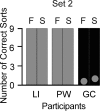Naming and categorization in young children: v. manual sign training
- PMID: 17575902
- PMCID: PMC1868580
- DOI: 10.1901/jeab.2007.52-06
Naming and categorization in young children: v. manual sign training
Abstract
Following pre-training with everyday objects, 8 children aged from 2 to 4 years learned to produce one manual sign (fists placed one above the other, in front of body) to one stimulus and an alternative manual sign (shoulders touched with ipsilateral hands) to the other stimulus, with each of three pairs of different arbitrary wooden shapes (Set 1). The six stimuli then were presented in category match-to-sample tests, which all subjects passed. Three of the children were next trained to produce the manual signs (denoted as fist/shoulder) for an additional six arbitrary stimuli, Set 2. All 3 children went on to pass category match-to-sample tests for Set 2, and for Set 1 and Set 2 combined. In the final experimental phase, 2 of the children were trained, for one of the six stimulus pairs, to produce the vocal tact "zag" to one stimulus and "vek" to the other. Both children showed category transfer of these vocalizations in test trials with each of the remaining five stimulus pairs, and all the stimuli combined in a 12-stimulus array. In line with Horne and Lowe's (1996) naming account, manual sign naming was found to be as effective as vocal naming in establishing arbitrary stimulus categorization, measured in terms of category sorting and transfer of function. The findings also have implications for the training of verbal repertoires in people with learning disabilities.
Figures




Similar articles
-
Naming and categorization in young children: III. Vocal tact training and transfer of function.J Exp Anal Behav. 2005 Jan;83(1):47-65. doi: 10.1901/jeab.2005.31-04. J Exp Anal Behav. 2005. PMID: 15762380 Free PMC article.
-
Naming and categorization in young children: IV: listener behavior training and transfer of function.J Exp Anal Behav. 2006 Mar;85(2):247-73. doi: 10.1901/jeab.2006.125-04. J Exp Anal Behav. 2006. PMID: 16673828 Free PMC article.
-
Naming and categorization in young children: vocal tact training.J Exp Anal Behav. 2002 Nov;78(3):527-49. doi: 10.1901/jeab.2002.78-527. J Exp Anal Behav. 2002. PMID: 12507018 Free PMC article.
-
Naming: What Do We Know So Far? A Systematic Review.Perspect Behav Sci. 2023 May 12;46(3-4):585-615. doi: 10.1007/s40614-023-00374-1. eCollection 2023 Dec. Perspect Behav Sci. 2023. PMID: 38144546 Free PMC article. Review.
-
A Manual of the Diseases of Children.Br Foreign Med Chir Rev. 1861 Apr;27(54):367-380. Br Foreign Med Chir Rev. 1861. PMID: 30163682 Free PMC article. Review. No abstract available.
Cited by
-
Training Intraverbal Naming to Establish Matching-to-Sample Performances.Anal Verbal Behav. 2015 Sep 29;31(2):162-82. doi: 10.1007/s40616-015-0040-4. eCollection 2015 Oct. Anal Verbal Behav. 2015. PMID: 27606210 Free PMC article.
-
Common and Intraverbal Bidirectional Naming.Anal Verbal Behav. 2016 Oct 25;32(2):125-138. doi: 10.1007/s40616-016-0066-2. eCollection 2016 Oct. Anal Verbal Behav. 2016. PMID: 30800621 Free PMC article.
-
Talk-Aloud Protocols during Conditional Discrimination Training and Equivalence Class Formation.Anal Verbal Behav. 2017 May 2;33(1):80-97. doi: 10.1007/s40616-017-0081-y. eCollection 2017 Jun. Anal Verbal Behav. 2017. PMID: 30854288 Free PMC article.
-
Naming of Stimuli in Equivalence Class Formation in Children.Anal Verbal Behav. 2021 Mar 10;37(1):77-96. doi: 10.1007/s40616-021-00143-8. eCollection 2021 Jun. Anal Verbal Behav. 2021. PMID: 34395167 Free PMC article.
-
A quarter century of the analysis of verbal behavior: an analysis of impact.Anal Verbal Behav. 2009;25(1):109-21. doi: 10.1007/BF03393075. Anal Verbal Behav. 2009. PMID: 22477434 Free PMC article.
References
-
- Acredolo L.P, Goodwin S.W. Sign language in babies: The significance of symbolic gesturing for understanding language development. Annals of Child Development. 1990;7:1–42.
-
- Baer D.M, Deguchi H. Generalized imitation from a radical-behavioral view-point. In: Reiss S, Bootzin R, editors. Theoretical issues in behavior therapy. New York: Academic Press; 1985. pp. 179–217.
-
- Brackenbury T, Ryan T, Messenheimer T. Incidental word learning in a hearing child of deaf parents. Journal of Deaf Studies and Deaf Education. 2006;11:76–93. - PubMed
-
- Casey L.O. Development of communicative behavior in autistic children: A parent program using manual signs. Journal of Autism and Childhood Schizophrenia. 1978;8:45–59. - PubMed
Publication types
MeSH terms
LinkOut - more resources
Full Text Sources
Miscellaneous

